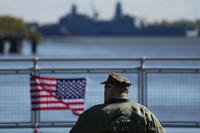As the U.S. Air Force navigates operations amid the "new abnormal" of coronavirus response efforts, its top general said he expects the ramp-up of virus precautions to be a cyclical event until a vaccine is developed.
"Until we have a vaccine, we're going to be living with this virus. And the potential for it to come back in some cyclical way is likely," Chief of Staff Gen. David Goldfein told reporters Wednesday in a teleconference.
"We are all looking at the future of studying the model, studying the science," Goldfein said, adding "some of the best science" and predictive models are being discussed with U.S. Northern Command leadership.
Recent epidemiological models project that the virus could have a second peak in coming months if quarantine or stay-at-home orders are relaxed.
Related: Air Force Deciding What Missions It Can Drop or Delay During Pandemic
Earlier this month, Goldfein asked commanders to review the list of mission-critical tasks that units must achieve in the coming months despite pandemic response efforts. Calling the effort a "reset" to determine which operations are absolutely necessary and which can be pushed off until later, he said it would also aid in protecting airmen.
The "new reset," Goldfein said Wednesday, will also assess how airmen can live and operate if the virus makes a resurgence after its initial peak.
"This in some ways is an opportunity to somewhat get back to our roots ... and really think through, 'How do we operate? How do we look at every base which is unique and different, and not apply a one-size-fits-all [approach], but rather have that local installation commander [make that determination?]'" Goldfein said.
Last week, he told Air Force Magazine there are some missions that take priority over others, including standing up the military's newest branch, the U.S. Space Force; combat operations around the world that require intelligence, surveillance and reconnaissance sharing; nuclear deterrence; and cyber operations.
The service has been working to stave off the disease's spread as much as possible across the force, officials have said.
For example, missileers keeping watch in nuclear silos have altered their schedules to keep watch on 14-day shifts or longer, Air Force Magazine reported. Airmen typically perform eight alert missions per month, each two to three days long, the magazine said.
Goldfein said the "blue and silver" duty shifts with specific windows -- a practice also in place at other bases -- has helped further mitigate the possibility of interaction and disease spread.
"For the crews that are performing that mission ... those have been COVID-19 free," Goldfein said.
-- Oriana Pawlyk can be reached at oriana.pawlyk@military.com. Follow her on Twitter at @Oriana0214.
Read more: President Trump Orders Navy to 'Destroy' Iranian Boats That Harass US Vessels













